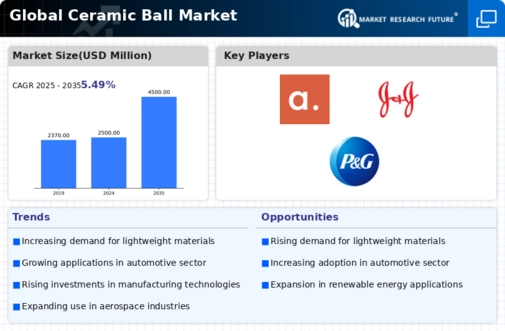Top Industry Leaders in the Ceramic Ball Market

Ceramic Ball Market
These tiny but mighty spheres, made from various ceramic materials like alumina, silicon nitride, and zirconia, find their way into diverse applications across industries. From grinding minerals and polishing gemstones to serving as bearings in high-performance machines, ceramic balls offer superior wear resistance, corrosion protection, and thermal stability compared to traditional metal alternatives.
Key Players and Strategies:
The market is characterized by a mix of established players and emerging entrants vying for a share of the pie. Some of the prominent players include:
-
Saint-Gobain: A leading global player with a strong presence in the alumina ceramic ball segment. -
Kyocera Fine Ceramics: Japanese giant with expertise in advanced ceramics, including zirconia balls for high-demand applications. -
Zhejiang Jiale Ceramic Balls Co., Ltd.: Chinese manufacturer known for its cost-competitive offerings. -
Wuhan Jinrui Wear Resistant Materials Co., Ltd.: Another Chinese player focusing on grinding media and bearing balls. -
Zirconia Corporation of America: US-based company specializing in high-performance zirconia products, including grinding balls.
Strategies adopted by these players include:
-
Product diversification: Expanding product portfolios to cater to different application needs and price points. For example, offering a range of alumina balls with varying grades and sizes. -
Technological advancements: Investing in research and development to improve product performance and efficiency. This could involve developing new ceramic compositions or manufacturing processes. -
Geographic expansion: Entering new markets or strengthening existing ones through acquisitions or partnerships. Emerging economies like China and India present significant growth potential. -
Vertical integration: Gaining control over the supply chain by acquiring raw material sources or manufacturing facilities. This can improve cost-efficiency and product quality. -
Focus on sustainability: Developing environmentally friendly production processes and offering recyclable or reusable ceramic balls.
Factors Influencing Market Share:
-
Material selection: Different applications require specific ceramic materials with varying properties. For instance, alumina is preferred for general grinding, while zirconia excels in high-temperature environments. -
Cost competitiveness: Price remains a crucial factor, especially for bulk applications. Asian manufacturers often offer cost-effective options, while European and American players command premium prices for high-quality products. -
Technological innovation: Players that constantly innovate and offer advanced solutions can gain a competitive edge. This includes developing new ball shapes, surface treatments, or customized solutions for specific customer needs. -
Regional trends: The growth of different industries in various regions influences demand. For example, the rise of the automotive industry in China drives the demand for ceramic ball bearings. -
Environmental regulations: Increasing focus on sustainability could lead to demand for eco-friendly ceramic balls or those used in clean energy technologies.
Key Players:
- CoorsTek Inc - CERBEC
- Devson Catalyst – DEV
- Saint-Gobain – Denstone
- Industrial Tectonics Inc -Silicon Nitride Balls
- Axens
- Honeywell International Inc
- TOSHIBA MATERIALS CO., LTD
- GLOBAL PRECISION BALL AND ROLLER
- FineWay Inc
- MetalBall
Recent Developments:
August 2023: Kyocera Fine Ceramics develops a new type of zirconia ball with enhanced wear resistance, specifically designed for grinding abrasive materials.
September 2023: Zhejiang Jiale Ceramic Balls Co., Ltd. partners with a European distributor to expand its reach in the European market.
October 2023: Wuhan Jinrui Wear Resistant Materials Co., Ltd. secures funding for a research project aimed at developing new ceramic ball materials for the aerospace industry.
November 2023: The European Union proposes new regulations restricting the use of certain hazardous materials in grinding media, potentially impacting the demand for some traditional ceramic ball compositions.
December 2023: A study published in a leading scientific journal highlights the potential of ceramic balls in reducing energy consumption during mineral processing, boosting their appeal for environmentally conscious industries.

